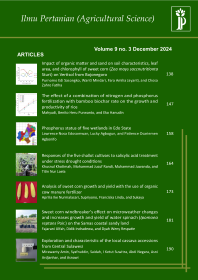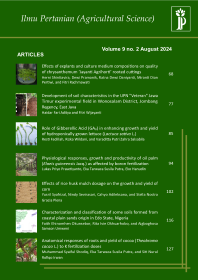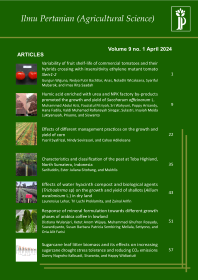
Genetic Diversity of Croton (Codiaeum variegatum (L.) Rumph.ex A. Juss) and Its Offspring Based on RAPD Markers
Mufit Daryatun Asniawati(1*), Aziz Purwantoro(2)
(1) Faculty of Agriculture Universitas Gadjah Mada, Yogyakarta
(2) Faculty of Agriculture Universitas Gadjah Mada, Yogyakarta
(*) Corresponding Author
Abstract
Croton (Puring) is a native plant of Indonesia which has varied leaf shapes and colors. The diversity of croton increase through hybridization. The information on genetic diversity and relationship between parent and its offspring of crotons is very limited. This study aims to analyze the genetic diversity of cultivar Mawar (MW) and Walet (W) as parent compare to their offspring i.e, Black Marlet (BM), Kingkit 1 (KA), Kingkit 2 (KB), and Kamaratih (KM) using RAPD markers. This study used DNA extraction from the fresh leaf of six cultivars. The next steps were DNA quantification, primary optimization, DNA amplification with PCR, and electrophoresis. Statistical analysis was carried out using Genalex software. A total of 40 primers were screened, out of which 10 were selected for the analysis of genetic diversity. A total of 106 polymorphic bands were generated, ranging from 130 to 1850 bp. The results of RAPD analysis showed that Mawar as female parent had the highest polymorphic bands percentage of 69.01%, while Walet as male parent and its offspring ranged from 31.15 % to 43.94%. The genetic distance of the offspring with Walet ranged from 0.176 to 0.234 and genetic distance of the offspring with Mawar ranged from 0.314 to 0.372. It was indicated that all of offspring were closer to the male parent.
Keywords
Full Text:
PDFReferences
Akhare, A.A., S.B. Sakhare, P.L. Kulwal, D.B. Dhumale and A. Kharkar. 2008. RAPD profile studies in Sorghum for identification of hybrids and their parents. International Journal of Integrative Biology 3 (1): 18-24.
Andersen, R. and Lubberstedt, T. 2003. Functional marker in plants. Trends in Plant Science, 8(11):554-560.
Andreastuti-K, M., A. Purwantoro and R.H. Murti. 2015. Molecular divesity of garden croton (Codiaeum variegatum (L.) Rumph. ex A. Juss) based on RAPD marker. Vegetalika 4(2):90-99.
Asif, M., M. Ur Rahman., J.I. Mirza and Y. Zafar. 2009. Parentage confirmation of cotton hybrids using molecular markers. Pak. J. Bot., 41(2):695-701.
Crochemore, M.L., C. Huyghe, M.C. Kerlan, F. Durand, dan B Julier. 1996. Partitioning and distribution of RAPD variation in a set of populations of the Medicago sativa complex. Agronomie, 16:421-432.
Deng, M., J. Chen, R.J. Henny dan Q. Li. 2010. Chromosome number and karyotype variation in Codiaeum variegatum cultivars. HortScience, 45(4):538-540.
Enjelina, W., Mansyurdin and T. Meideliza. 2018. Analysis of natural hybrid Kantung Semar (Nepenthes) in Bukik Taratak West Sumatra with RAPD technique. Eksakta, 19: 12-20.
Farzaneh, T., M. Sheidai, Z. Nourmohammadi , O. Alishah and F. Farahani. 2010. Cytogenetic and RAPD analysis of cotton cultivars and their F1 progenies. Caryologia, 63 (1): 73-81.
Guasmi F.,W. Elfalleh, H. Hannachi, K. Feres, L. Touil, N. Marzougui, T. Triki, and A. Ferchichi. 2012. The use of ISSR and RAPD markers for genetic diversity among South Tunisian barley. ISRN Agronomy:1-11.
Huang, S.C., C.C. Tsai and C.S. Sheu. 2000. Genetic analysis of chrysanthemum hybrids based on RAPD molecular markers. Botanical Bulletin of Academia Sinica, (41):257 – 262.
Ilbi, H. 2003. RAPD markers assisted varietal identification and genetic purity test in pepper, Capsicum annuum. Scientia Horticulturae, 97:211–218.
Kobayashi N., M. Akabane, T. Handa and K. Takayanagi. 1996. Inheritance of morphological characters and RAPD markers in intersubgeneric hybrids of azalea (Rhododendron kiusianum Makino x R. indicum (L.) Sweet) x R. japonicum (A. Gray) Suringer f. flavum Nakai. J. Japan. Soc. Hort. Sci., 65(1):145-153.
Li, G. and C.F. Quiros. 2001. Sequence-related amplified polymorphism (SRAP), a new marker system based on a simple PCR reaction: its application to mapping and gene tagging in Brassica. Theor. Appl. Genet. 103: 455–461.
López-Caamal, A. and E. Tovar-Sánchez. 2014. Genetic, morphological, and chemical patterns of plant hybridization. Revista Chilena de Historia Natural, 87(16): 1-14.
Lynch, M dan B.G. Milligan. 1994. Analysis of population genetic structure with RAPD markers. Molecular Ecology, 3:91-99.
Magdalita, P.M., N.K. Torreta, and R.C. Sotto. 2014. Characterization of phenotypic variation in selected croton [Codiaeum variegatum (L.) Rhumph. ex A. Juss.] varieties and natural mutants. Journal of Nature Studies, 13(2): 41-55.
Martanti, D., Y.S Poerba and Herlina. 2017. Genetic analysis of diploid banana hybrids based on RAPD Markers. Berita Biologi, 16(3): 257-264.
Mehetre S.S., M. Gomes, E. Susan, A.R. Aher, and G.C. Shinde. 2004. RAPD and cytomorphological analyses of F1, F2 and amphidiploid (A1) generations of Gossypium arboreum x Gossypium capitis-viridis. Cytologia, 69(4):367–379.
Mei, Z., B. Zhou, C. Wei, J. Cheng, S. Imani, H. Chen and J. Fu. 2015. Genetic authentication of Gardenia jasminoides Ellis var. grandiflora Nakai by improved RAPD-derived DNA markers. Molecules, 20:20219–20229.
Mollick, A.S., H. Shimoji, T. Denda, M.Yokota, dan H. Yamasaki. 2011. Croton Codiaeum variegatum (L.) Blume cultivars characterized by leaf phenotypic parameters. Scientia Horticulturae, 132:71–79.
Mollick , A.S. and H. Yamasaki. 2012. Phenotypic variation in croton Codiaeum variegatum (L.) Blume characterized by digital image-based procedure. Acta Hortic., 937:393-400.
Abstr. Available at https://doi.org/10.17660/ActaHortic.2012.937.48. (Accessed 20 Oct. 2018).
Nag, N., K.Taski-Ajdukovic, G. Barac, A. Baburski, I. Seccareccia, D. Milic dan S. Katic. 2011. Estimation of the genetic diversity in tetraploid alfalfa populations based on RAPD markers for breeding purposes. International Journal Molecular Science, (12):5449-5460.
Ogunwenmo, K.O., O.A.Idowu, C. Innocent, E.B. Esan, dan O.A. Oyelana. 2007. Cultivars of Codiaeum variegatum (l.) Blume (Euphorbiaceae) show variability in phytochemical and cytological characteristics. African Journal of Biotechnology, 6(20):2400-2405.
Peakall, R and P. Smouse.2007. Appendix-1 methods and statistics in GenAlEx 6.1. 27 p
Penner G.A., A. Bush, R. Wise, W. Kim, L. Domier, K. Kasha, A. Laroche, G. Scoles, S.J. Molnar and G. Fedak. 1993. Reproducibility of random amplified polymorphic DNA (RAPD) analysis among laboratories. Research, 2:341-345.
Rahman, A.H.M.M dan M. Akter. 2013. Taxonomy and medical uses of Euphorbiaceae (Spurge) family of Rajshashi, Bangladesh. Research in Plant Sciences, 1(3):74-80.
Rajesh M.K., B.A. Jerard, P. Preethi, R.J. Thomas and A. Karun. 2014. Application of RAPD markers in hybrid verification in Coconut. Crop Breed. Appl. Biotechnol, 14(1):36-41.
Shimoji H., G. Tokuda, Y. Tanaka, B. Moshiri, and H. Yamasaki. 2006. A Simple Method for Two-Dimensional Color Analyses of Plant Leaves. Russian Journal of Plant Physiology, 53(1):126–133.
Stamps R.H. and L.S. Osborne. 2003. Croton production and use. Circular ENH 878, Series of the Environmental Hort EIDS, Dept, Florida Coop Ext Services, IFAS, Univ Florida EIDS. Available at http://edis.ifas.ufl.edu. (Accessed 20 Oct. 2018).
Taški-Ajduković, K., N. Nag, D. Milić, S. Katić, and M Zorić. 2014. Genetic variation and relationship of alfalfa populations and their progenies based on RAPD markers. Cent. Eur. J. Biol., 9(8):768-776.
Williams, J.G.K, A.R.Kubelik, K.J. Livak, J.A. Rafalski dan S.V. Tingey. 1990. DNA polymorphisms amplified by arbitrary primers are useful as genetic markers. Nucleic Acids Research, 18(22):6531-6535.
Wolff, K and J.P Van Rijn.1993. Rapid detection of genetic variability in chrysanthemum (Dendranthema grandflora Tzvelev) using random primers. Heredity, 71: 335-341.
Xu, Y. 2010. Molecular plant breeding. CAB International. USA. 717 p.Article Metrics
Refbacks
- There are currently no refbacks.
Ilmu Pertanian (Agricultural Science) ISSN 0126-4214 (print), ISSN 2527-7162 (online) is published by Faculty of Agriculture Universitas Gadjah Mada collaboration with Perhimpunan Sarjana Pertanian Indonesia (PISPI) and licensed under a Creative Commons Attribution-ShareAlike 4.0 International License.














